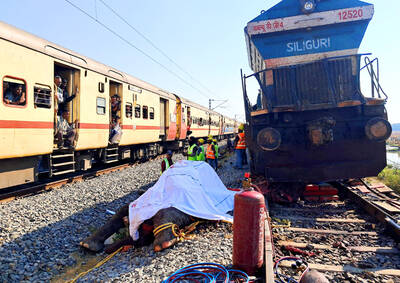Indian housewife Sujata Budarapu was shocked when she was told that her two sons were on the verge of developing Type 2 diabetes.
“It had never even occurred to me that this could happen. I had heard that outside India this happens to other people’s kids, but I never thought it would happen to my own,” the 38-year-old from Mumbai said.
Sujata’s children are not exceptional cases, even in a country more traditionally associated with malnourishment and chronic food shortages than overeating and weight-related illness.

Photo: AFP
India still struggles to feed all of its 1.2 billion population, but childhood obesity and diabetes have become an increasing problem among the middle classes, who have largely benefited from a decade of rapid economic growth.
“Childhood obesity has definitely increased in the last couple of years,” said Paula Goel, from the Fayth Clinic in Mumbai, which runs a weight loss program for adolescents. “This is mainly because ... they’re not playing on the fields and they’re spending so much time on sedentary activities that come with the affluent lifestyle. Visiting the malls over the weekends, eating junk food, it’s bound to cause obesity.”
At 12 years old, Sujata’s youngest son, Saiprasad, watches three hours of television every day and weighs 66kg when he should be between 52kg and 58kg.
Her eldest boy, Sairaj, 15, tips the scales at 89kg — more than 30kg overweight.
Both boys love eating oil-rich and fast food and are on medication to control their sugar levels. They have been attending Goel’s clinic for the last three months.
Anoop Misra, president of the Center for Diabetes, Obesity and Cholesterol Disorders in New Delhi, says India has the highest number of diabetics in the world at just under 51 million people, but that number could increase by nearly 150 percent in the next 20 years.
The high number of cases among South Asian people has been attributed to genetic factors, including a predisposition to storing more fat.
Socio-environmental factors, though, are now seen as playing an increasing role in the rising number of cases of Type 2 diabetes.
The condition, which occurs when the body cannot effectively use the insulin it makes, largely as a result of excess body weight and physical inactivity, was previously seen mainly in older people.
High-fat, high-sugar, fast food outlets proliferate in Indian cities, catering for a hard-working, time-poor population eager to spend its new-found cash, with Western brands often chosen as a visible sign of wealth.
“All over the world, except India, people love bland, less spicy food,” said Himank Doshi, a medical student tucking into a takeaway from a stall on Mumbai’s Chowpatty Beach. “They love the boiled food and all for the nutrition, but Indian people are less concerned about nutrition. They first focus on the spice of the food, the taste.”
That mindset, plus a decline in physical activity through increased car use and a lack of open spaces for exercise, is a dangerous combination.
A study of 4,000 Indian children in 15 cities published in August last year indicated that almost a quarter (23 percent) of five to 14-year-olds in urban schools were overweight, while nearly 11 percent were obese.
Overweight children with diabetes are at greater risk of developing heart disease and heart attacks, deteriorating eyesight, kidney failure, high blood pressure and high cholesterol.
Many of Goel’s young patients already have mild depression because of their size.
The stakes are high — and not just for the nation’s health — India spent about US$40 billion on treating diabetes last year.
For Misra, prevention — from better health education to weight-loss clinics — is more cost-effective.
“If we prevent one case, we’ll be saving so much more money, rather than treating this for the lifetime,” he said. “So for a developing economy like India, it makes 100 percent sense to prevent something rather than treating it with expensive insulin and so on.”
Sujata realizes that life in modern India is partly to blame for her children’s predicament — and that change isn’t always for the better.
“If you look at the previous generation, we never went out to eat, we just ate home food. Everything was made at home. Now there’s more money and more illness because we’ve started to eat out more,” she said.

The Burmese junta has said that detained former leader Aung San Suu Kyi is “in good health,” a day after her son said he has received little information about the 80-year-old’s condition and fears she could die without him knowing. In an interview in Tokyo earlier this week, Kim Aris said he had not heard from his mother in years and believes she is being held incommunicado in the capital, Naypyidaw. Aung San Suu Kyi, a Nobel Peace Prize laureate, was detained after a 2021 military coup that ousted her elected civilian government and sparked a civil war. She is serving a

‘NO AMNESTY’: Tens of thousands of people joined the rally against a bill that would slash the former president’s prison term; President Lula has said he would veto the bill Tens of thousands of Brazilians on Sunday demonstrated against a bill that advanced in Congress this week that would reduce the time former president Jair Bolsonaro spends behind bars following his sentence of more than 27 years for attempting a coup. Protests took place in the capital, Brasilia, and in other major cities across the nation, including Sao Paulo, Florianopolis, Salvador and Recife. On Copacabana’s boardwalk in Rio de Janeiro, crowds composed of left-wing voters chanted “No amnesty” and “Out with Hugo Motta,” a reference to the speaker of the lower house, which approved the bill on Wednesday last week. It is

Seven wild Asiatic elephants were killed and a calf was injured when a high-speed passenger train collided with a herd crossing the tracks in India’s northeastern state of Assam early yesterday, local authorities said. The train driver spotted the herd of about 100 elephants and used the emergency brakes, but the train still hit some of the animals, Indian Railways spokesman Kapinjal Kishore Sharma told reporters. Five train coaches and the engine derailed following the impact, but there were no human casualties, Sharma said. Veterinarians carried out autopsies on the dead elephants, which were to be buried later in the day. The accident site

‘EAST SHIELD’: State-run Belma said it would produce up to 6 million mines to lay along Poland’s 800km eastern border, and sell excess to nations bordering Russia and Belarus Poland has decided to start producing anti-personnel mines for the first time since the Cold War, and plans to deploy them along its eastern border and might export them to Ukraine, the deputy defense minister said. Joining a broader regional shift that has seen almost all European countries bordering Russia, with the exception of Norway, announce plans to quit the global treaty banning such weapons, Poland wants to use anti-personnel mines to beef up its borders with Belarus and Russia. “We are interested in large quantities as soon as possible,” Deputy Minister of National Defense Pawel Zalewski said. The mines would be part